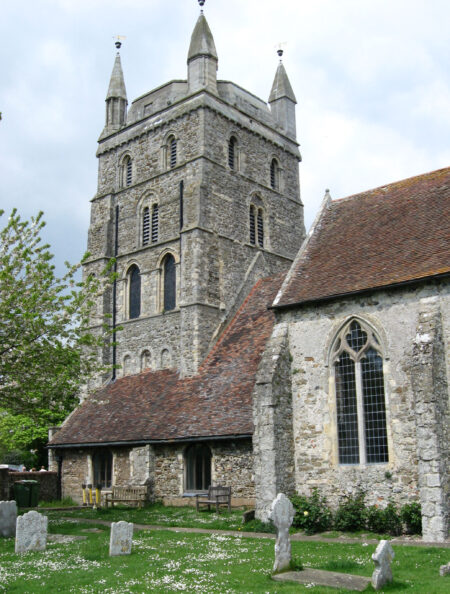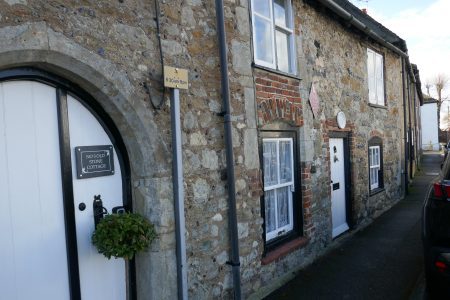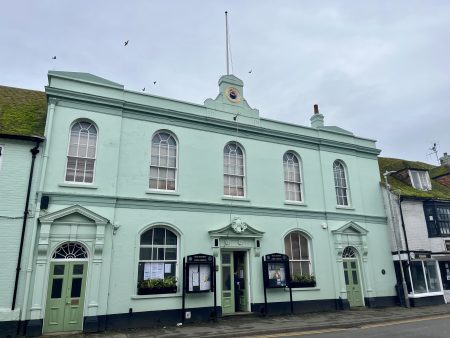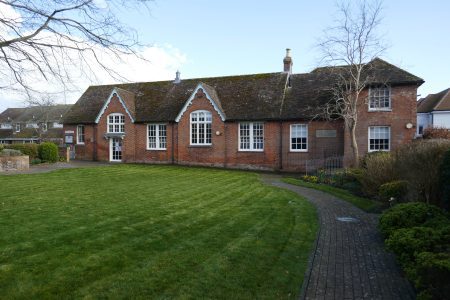NEW ROMNEY – THE LITTLE TOWN WITH A BIG HISTORY
A charming small town with a picturesque High Street, New Romney has many and varied delights, with a particular appeal for those interested in history and heritage.
Highlights: St Nicholas Church, the High Street, West Street, the Town Hall, the Old School, modern murals, Cinemarsh
Read on to find out more!
THE CRADLE OF THE NAVY
Before the Tudor reign, when a standing Navy was established, the men and ships of the Cinque Ports provided a fleet to meet the military and transportation needs of their Royal masters, and in return were granted a great deal of leeway in terms of respecting the law. Hence perhaps the rise of smuggling, for which the Marsh was also famous!
Cinque (pronounced ‘sink’ not ‘sank’) is from Norman French, meaning five ports. New Romney is one of the original five, even though it now stands over a mile from the sea, due to the Great Storm of 1287.


STORMY WEATHER
New Romney was almost destroyed in the Great Storm of 1287 when the River Rother burst its banks and changed course to run out into the sea near Rye, Sussex. The old harbour and the town itself were filled with sand, silt, mud and debris – which was never totally removed, explaining why many old buildings have steps leading down into them from the present pavement level.
ST NICHOLAS CHURCH
The Norman St Nicholas Church originally stood at the harbourside, with its doors below ground level nowadays. Look out for the boat hooks still mounted high up on the side walls!
Bishop Odo, the brother of William the Conqueror, saw building begin in 1086, using stone shipped from Caen, Normandy by French stonemasons. The building survived the destruction of the Great Storm, and work carried on in the 12th century Norman style with Gothic additions in the 13th and 14th centuries.
St. Nicholas’ tower contains eight bells, the largest of which is known as the Tenor and weighs over 15cwt. The church became Grade I listed on November 28 1950.


HOMES AND HISTORY
Along with an interesting range of independent shops, cafes, bars and restaurants, the High Street is home to a number of historic buildings. The former almshouses in West Street, used to house the poor of the parish, were founded by local landowner John Southland in 1610, and rebuilt in 1734.
Just off the High Street are the ruins of St John’s Priory, a mediaeval Cistercian Priory founded in the 13th century. The ruins themselves consist of a small building of stone rubble with a tiled roof, surrounded by a large garden.
Numbers 3 and 4 West Street date from 1310, and is one of the earliest surviving domestic dwellings in England. Originally a stone-built hall house, now separated into two, it was altered in around 1400 with the construction of a timber and stone jettied cross wing, followed by an enormous stone and brick stack replacing the open hearth in the Hall circa 1500. This high status 14th century housing is thought to have been a merchant’s house when New Romney was a busy port. The stone fronted building still has its original 14th century Gothic doorway.
The Assembly Rooms and Schoolroom are in Church Approach, just off the High Street. Said to have been built as the meeting place for the Courts of Brotherhood and Guestling, consisting of the representatives of the Cinque Ports and the Ancient Towns, the building was the called the Hall of the Ports and was also used as Assembly Rooms.
The Schoolroom is a small room adjoining on the north western side of the building, and was erected in 1676 – probably just before the Assembly Rooms.
New Romney Town Hall, originally commissioned by the local bailiff as a market hall, is in the Italianate style and was completed in 1702. The five-bayed symmetrical main frontage projects onto the High Street. The main room inside was a courtroom on the first floor –the venue for the inquest into the death in August 1867 of Louisa Kidder-Staples. Her step-mother, Frances Kidder, had the dubious honour, after being found guilty of Louisa’s murder, of becoming the last woman to be publicly hanged in Britain. Very conveniently for the courtroom, a Gaol and Sergeant’s House were built immediately next door.


Today The Old School is an important part of the town’s history, culture and social activities. From 1821 to 1967 it educated many generations of local children, before falling into disrepair. The foundation of the New Romney Old School Trust in 1988, extensive fund raising and a National Lottery grant enabled restoration and reopening in 2000. It is now a community centre and home to the town’s Heritage Collection, with a fascinating collection of items from the town and across the Marsh. Check website for opening times – www.newromneyoldschool.co.uk
MORE MODERN MASTERPIECES
A stroll through New Romney to catch some of our favourite sights will also give you a modern vibe – stunning contemporary murals depict scenes from local life. Look out for the fisherman, train driver, butcher, estate agent (yes, really!) and portraits of many people who have lived on the Marsh their whole life. Local scenes include the Martello Towers and Littlestone Water Tower, while an amazing sculpture outside Sainsbury’s celebrates the history of sheep farming on the Marsh.
If all that walking, wandering and wondering has left you needing a nice sit down, then you could always visit Cinemarsh, a 46 seat cinema with all the best new releases and some classics too, with about 20 screenings a week. Go to www.cinemarsh.co.uk for bookings and prices.

WHERE TO EAT
New Romney caters for all tastes and all budgets – among many options, you could pick up a picnic from Foodie’s Emporium, have a pie and a pint or a roast and a bottle of red at The Ship Hotel, or a coffee and a sandwich from The Old Coach House.
GETTING HERE
As always, it depends where you’re coming from!
By road, bus or bike, New Romney sits on the A259.
If you prefer a more romantic form of travel, hark back to the steam age with a journey on the Romney, Hythe and Dymchurch Railway – journey from Hythe or Dungeness, or hop on/hop off anywhere along the line. Tickets and bookings from www.rhdr.org.